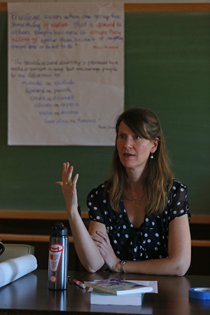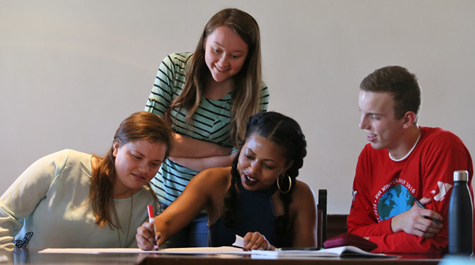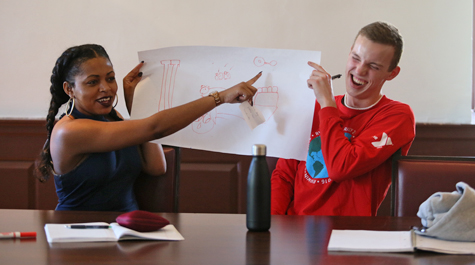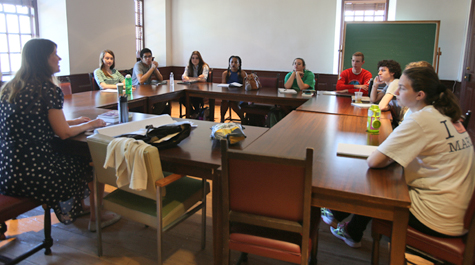Bringing community engagement into the classroom
It seemed like a friendly game of Pictionary until the two teams compared experiences.
One group of William & Mary students was handed a large piece of easel paper while the other had to make do with what could be pulled from a notebook. One was warned repeatedly not to cheat while the other was praised for its integrity. One was commended for its natural talent while the other was chastised for its limited vocabulary.
Finally, when one group read its assigned set of words aloud — words like “jail,” “police dog” and “cop car” — the other, which was given words including “recidivism,” “incarceration” and “probation,” cried foul.
“I’ve been bamboozled,” one student exclaimed.
She was right. It was a setup orchestrated by Melody Porter to introduce her Community Engagement in Context class to a particular topic.
“That was my way of starting off our conversation about privilege because it is an important thing to understand, and sometimes — especially for people who experience privilege in a lot of different ways — it can be hard for us to get our heads around or understand what that looks like,” Porter, director of the Office of Community Engagement, told her students.
Although Porter and her colleagues in OCE have long been teaching such concepts as part of the office’s direct service and outreach programs, in recent years they have begun offering courses for students who want to delve into community engagement concepts — and earn academic credit at the same time.
“Students really want to weave their active citizenship through the different parts of their life on campus and in community, and so having that coursework associated with it, especially for the first-year students, gives them a sense of knowledge and confidence that they don’t have without it,” said Elizabeth Miller, assistant director of OCE. “They both take more seriously the work they’ve done because they’ve investigated it through an academic lens but also are more serious about their investment in it.”
 Bringing the work of OCE into the classroom began several years ago when Drew Stelljes, now assistant vice president for student affairs, student engagement and leadership, was leading the office. He facilitated a program called Leadership in Community Engagement that was eventually approved for credit, said Porter.
Bringing the work of OCE into the classroom began several years ago when Drew Stelljes, now assistant vice president for student affairs, student engagement and leadership, was leading the office. He facilitated a program called Leadership in Community Engagement that was eventually approved for credit, said Porter.
“When I began teaching the course, I focused on theories and best practices of community engagement and how students who are already involved in community could do what they’re doing better by developing capacity-building projects with their partners,” said Porter. “Four years in, the course continues to focus on theory and practice, including readings on citizenship, race and privilege, research on the impacts of service-learning and globalization. Students are involved in weekly tutoring, mentoring, anti-hunger and other community engagement, and through their assignments, enrich their work with global perspective-taking and critical reflection on their active citizenship.”
Between the two of them, Porter and Miller now teach three community engagement courses: Community Engagement in Context, which is aimed at first-year students; Community Engagement on Campus, a one-credit, sophomore-focused course; and Applied Community Engagement: Leading Alternative Breaks. They have also partnered with the School of Education to begin connecting OCE programs to current courses and the curriculum and instruction department’s offerings, including the pending interdisciplinary educational studies minor.
In addition, Porter attended a January seminar hosted by the Center for Liberal Arts to learn how to adapt her course for the COLL 300 on campus designation next spring. She is currently awaiting approval of her proposal.
“It really propels what we’re doing with that program, and I think it also helps reveal the good work that students have been doing in their leadership with communities for a long time,” said Miller.
Although the community engagement opportunities offered through OCE do include learning and reflection components, the classes provide students a chance to go deeper through research and discussion.
“It gives students time and motivation to step back from their direct service experience and think about what are other things that are informing the work that is for them very personal and engaged,” said Miller.
Porter added, “It’s awesome for us because it’s the kind of conversations we often have with small groups of students who have time or interest in sort of lingering around after things happen or are in higher positional leadership roles, but this allows us to work with greater numbers of students and build up sort of a culture of critically informed community engagement.”
Dan Delmonaco, who graduated in December 2016, took Porter’s Community Engagement in Context class in the spring of 2015 because he thought it would be a good opportunity to learn skills that would be useful both in college and beyond.
“All the people in the class were so passionate about what they were working on and just super inspiring,” he said.
Katie Conely ’16, who now serves as the OCE fellow for health, hunger and nutrition, also found community in the class, which she took last spring.
“What I really liked from the class — probably because it was a higher-level class — was that a lot of it was student-driven,” she said. “Melody would facilitate and provide feedback, but it was a really cool summit of student service leaders on campus. I learned about a lot of different groups on campus I didn’t know about before. It just made those connections, and I’m definitely using a lot of those connections now in the work that I’m doing. It was cool as well that even though it was upper-level we had all four years represented. We had a freshman in the room, and it was really cool to see what she took away from it and see what ideas she brought to the table.”
With a continued high level of interest from students, Porter and Miller see a lot of room to expand their academic offerings for not only the benefit of students, but the campus and local communities as well.
“They’re doing really critical work, and I think it only makes our programs better when they know more and have a chance to be more reflective, to hear more expert opinions and to do more reading, so that’s what we want to be offering,” said Porter.

















